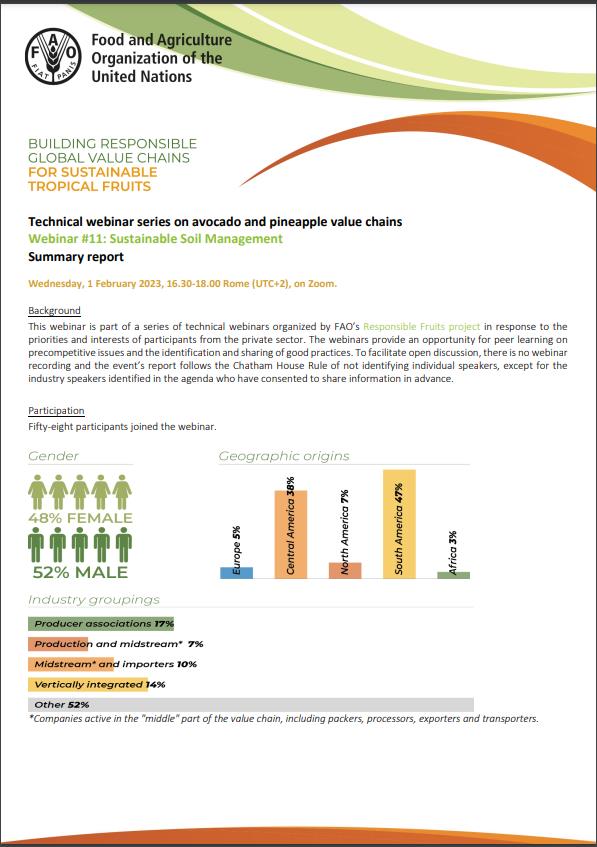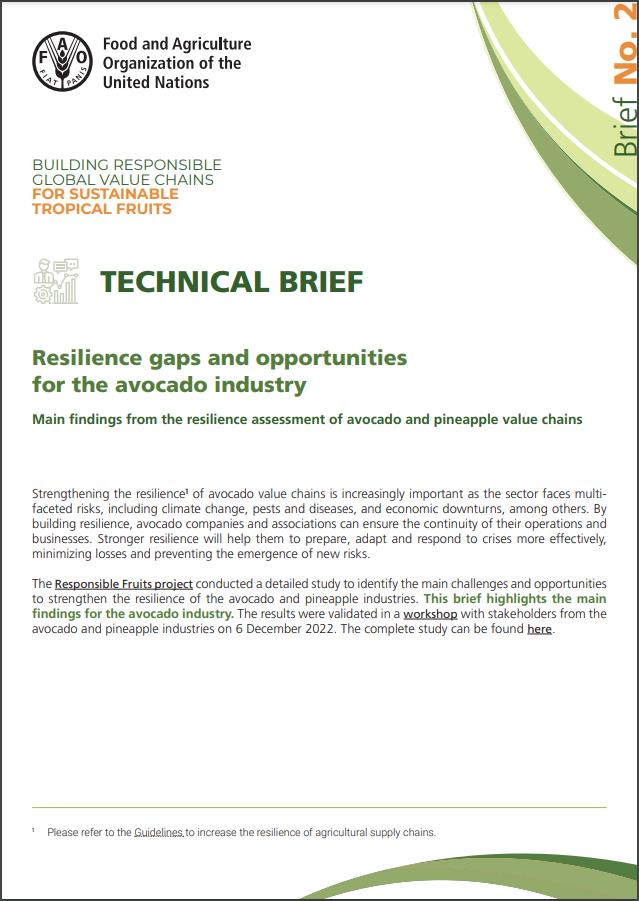
Resilience gaps and opportunities for the avocado industry
06/07/2023
Strengthening the resilience of avocado value chains is increasingly important as the sector faces multifaceted risks, including climate change, pests and diseases, and economic downturns, among others. By building resilience, avocado companies and associations can ensure the continuity of their operations and businesses.
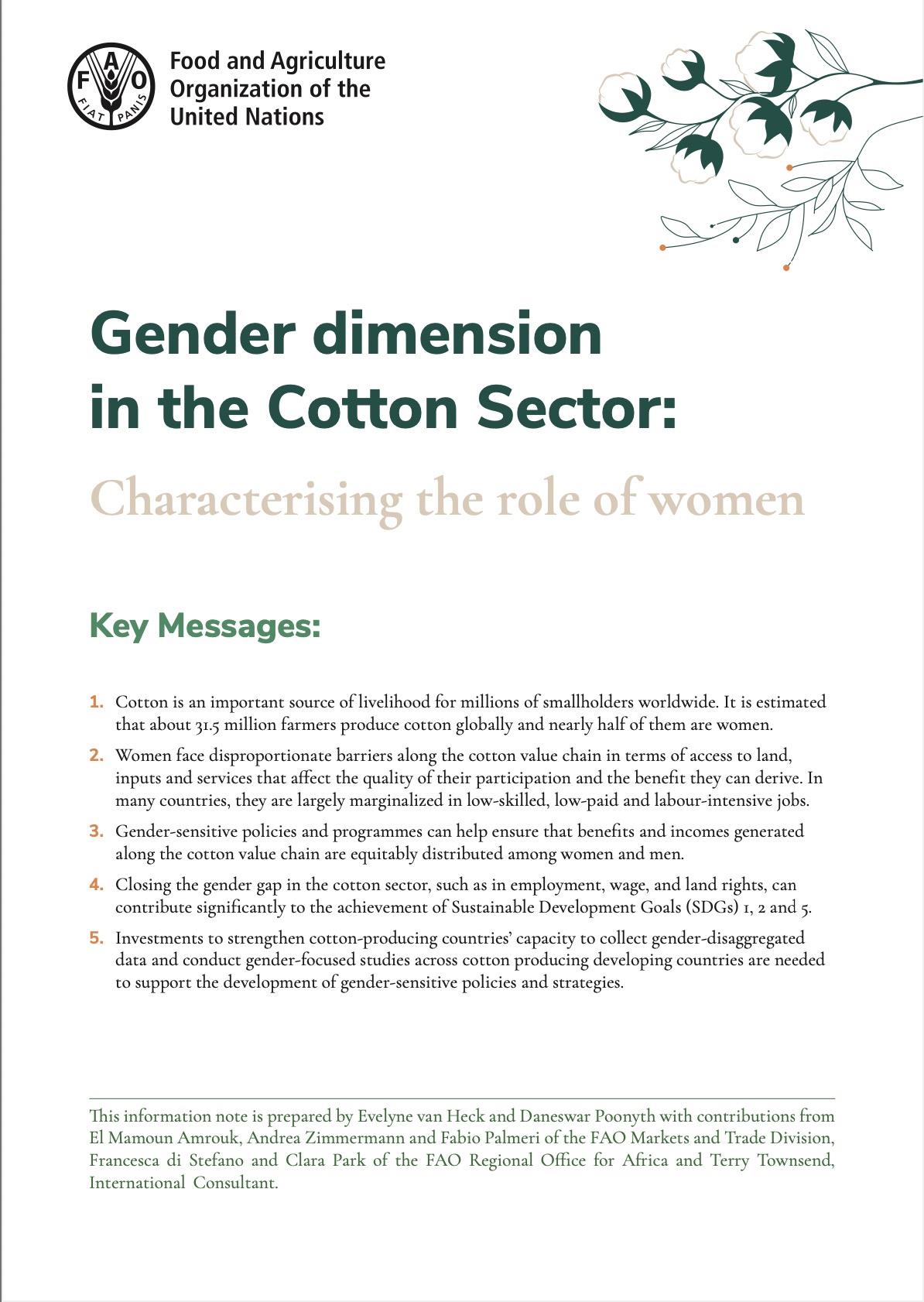
Gender dimension in the Cotton Sector: characterising the role of women
05/07/2023
Cotton is an important source of livelihood for millions of smallholders worldwide and women contribute significantly to cotton farming, constituting a large share of the workforce involved in primary production. However, women face disproportionate barriers along the cotton value chain in terms of access to land, inputs and services that affect the quality of their participation and the benefit they can derive.
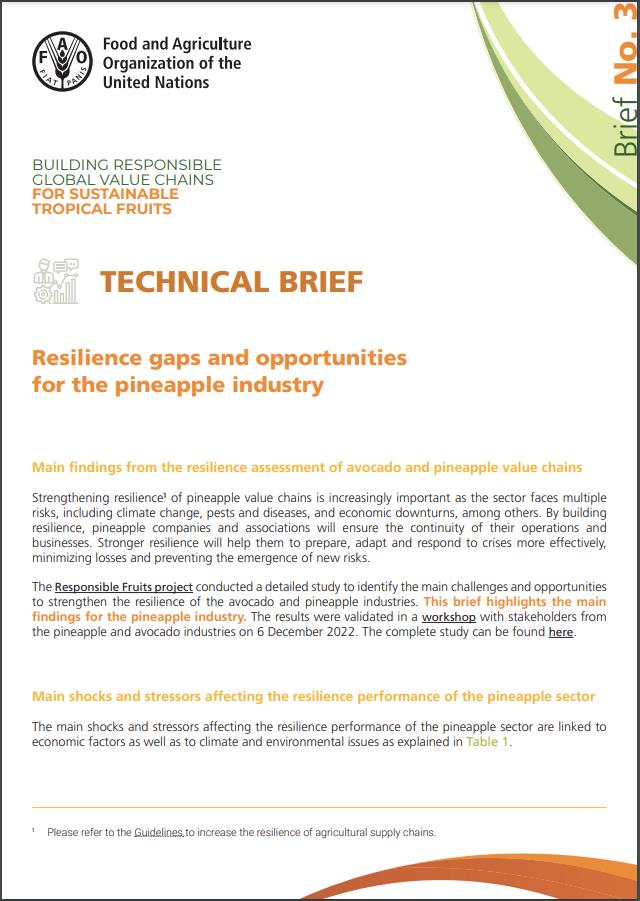
Resilience gaps and opportunities for the pineapple industry
04/07/2023
Strengthening the resilience of avocado value chains is increasingly important as the sector faces multifaceted risks, including climate change, pests and diseases, and economic downturns, among others. By building resilience, avocado companies and associations can ensure the continuity of their operations and businesses.
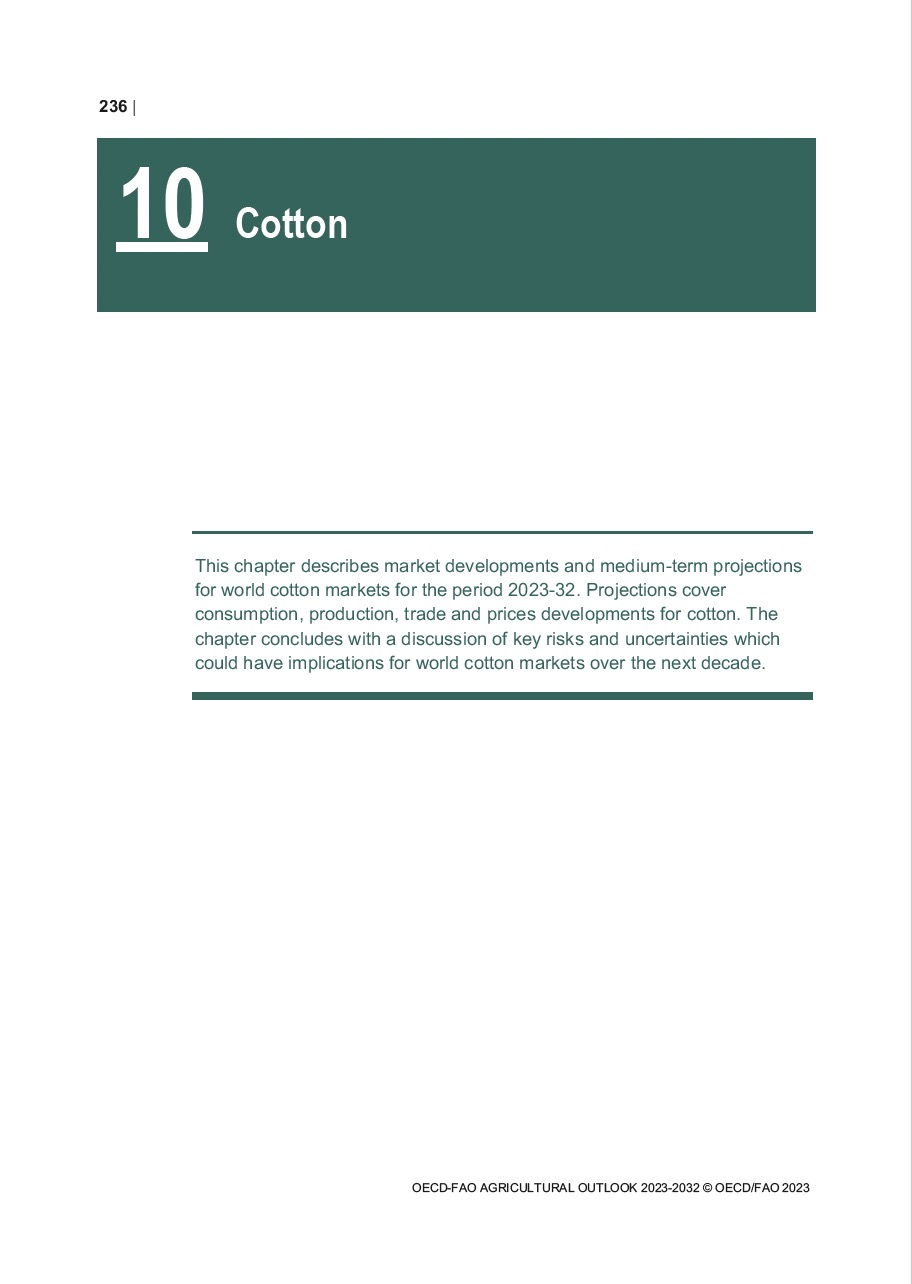
OECD-FAO Agricultural Outlook 2023-2032: Chapter 10 (Cotton)
03/07/2023
This chapter describes market developments and medium-term projections for world cotton markets for the period 2023-32. Projections cover consumption, production, trade and prices developments for cotton. The chapter concludes with a discussion of key risks and uncertainties which could have implications for world cotton markets over the next decade.
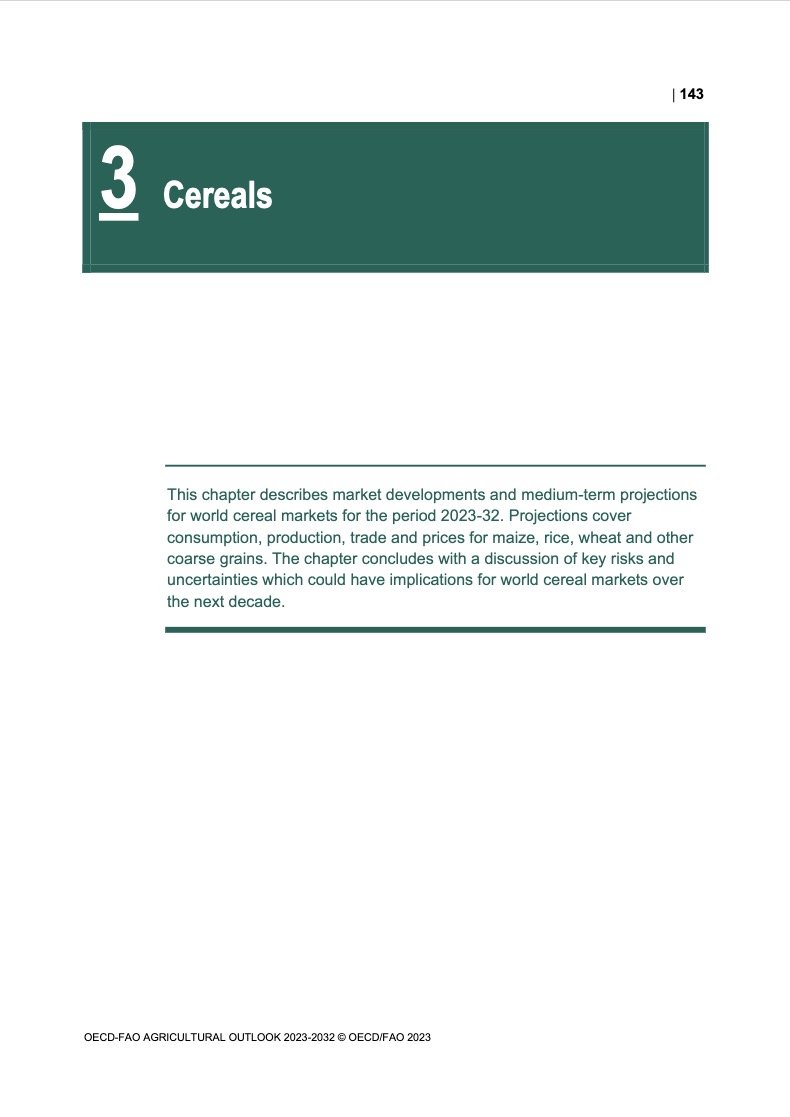
OECD-FAO Agricultural Outlook 2023-2032: Chapter 3 (Cereals)
01/07/2023
This chapter describes market developments and medium-term projections for world cereal markets for the period 2023-32. Projections cover consumption, production, trade and prices for maize, rice, wheat and other coarse grains. The chapter concludes with a discussion of key risks and uncertainties which could have implications for world cereal markets over the next decade.
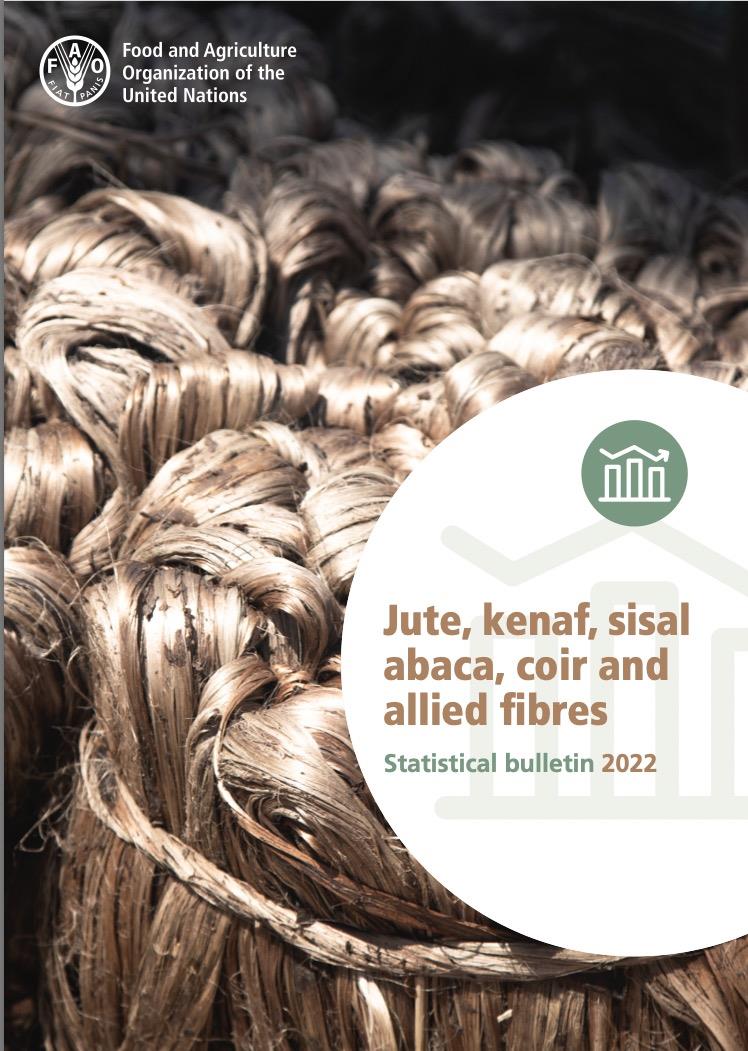
Jute, kenaf, sisal abaca, coir and allied fibres Statistical bulletin 2022
28/06/2023
The Market and Policy Analysis of Raw Materials, Horticulture and Tropical Products Team (RAMHOT), provides economic data and analysis on major agricultural raw materials and tropical products, including hard fibres (abaca, coir and sisal), jute, kenaf and allied fibres. The tables contained in this document bring together governments’ replies to the latest questionnaires, supplemented by other data available to the Secretariat at 31 December 2022.
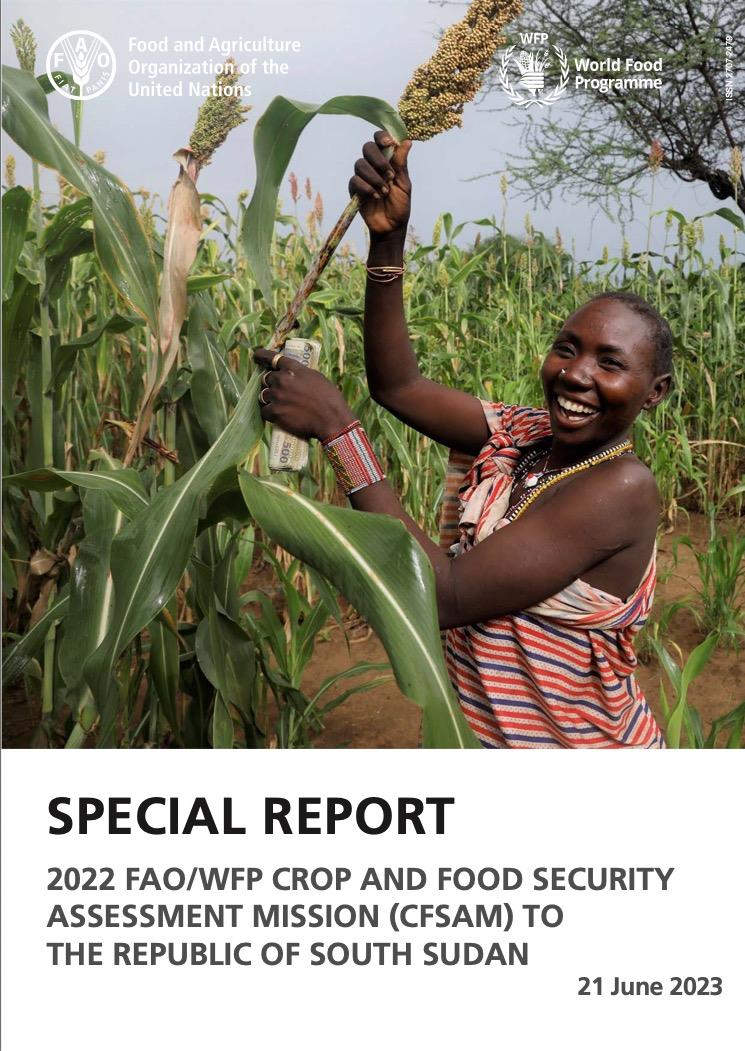
Special Report – FAO/WFP Crop and Food Security Assessment Mission (CFSAM) to the Republic of South Sudan
21/06/2023
The annual FAO/WFP Crop and Food Security Assessment Mission (CFSAM) was conducted from 1 to 16 December 2022 to estimate the cereal production in South Sudan during 2022 and assess the overall food security situation in the country. The CFSAM reviewed the findings of several crop assessment missions conducted at planting and harvest time from June to November 2022 in different agroecological zones of the country. All missions were carried out by a crop assessment Task Force Team comprising staff from the Ministry of Agriculture and Food Security (MoAFS), the National Bureau of Statistics (NBS), the Food and Agriculture Organization of the United Nations (FAO) and the respective State Ministry of Agriculture (SMoA). Task Force Team members were trained to conduct rapid assessments using established CFSAM instruments, protocols and techniques, including walking transects, scoring standing crops and livestock body conditions according to the Pictorial Evaluation Tool (PET),ii crop cuttings to assess yields, performing key informant interviews and farmer case studies.
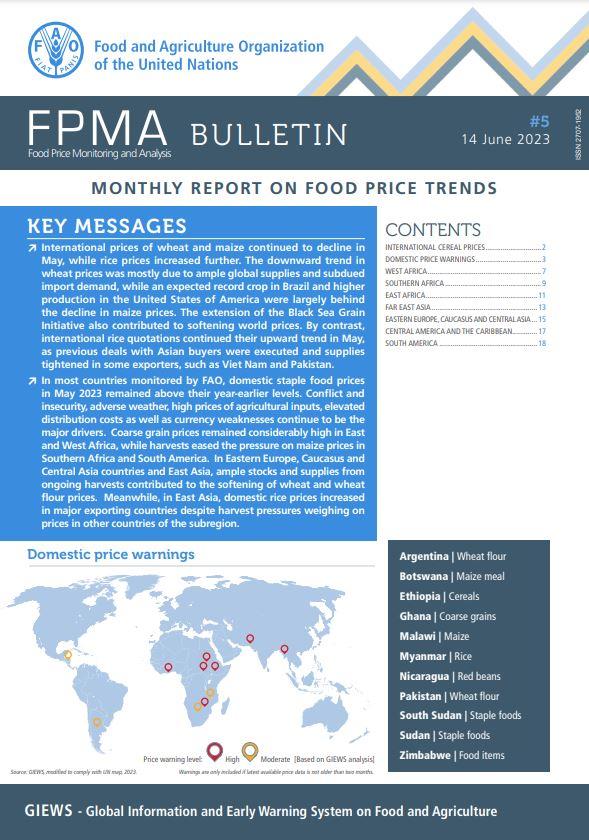
Food Price Monitoring and Analysis (FPMA) Bulletin #5, 14 June 2023 - Monthly report on food price trends
15/06/2023
International prices of wheat and maize continued to decline in May, while rice prices increased further. The downward trend in wheat prices was mostly due to ample global supplies and subdued import demand, while an expected record crop in Brazil and higher production in the United States of America were largely behind the decline in maize prices. The extension of the Black Sea Grain Initiative also contributed to softening world prices.
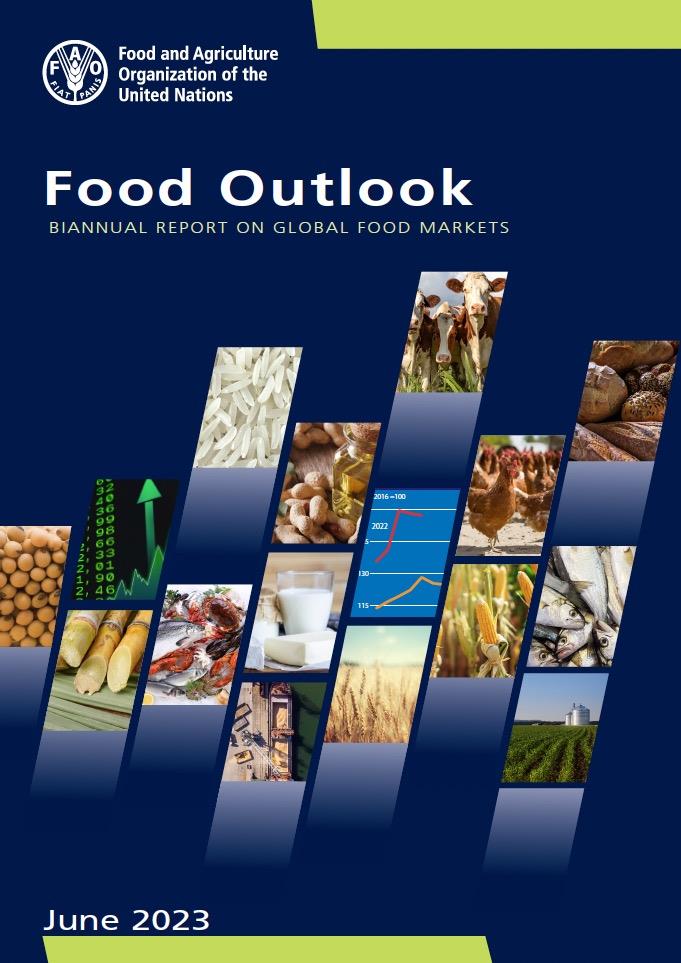
Food Outlook – Biannual Report on Global Food Markets - June 2023
15/06/2023
FAO’s latest forecasts point to increases in production and higher stocks across several basic foodstuffs. However, global food production systems remain vulnerable to shocks, stemming from weather conditions, geopolitical tensions and policies, potentially tipping the delicate demand-supply balances, with implications for global food security.
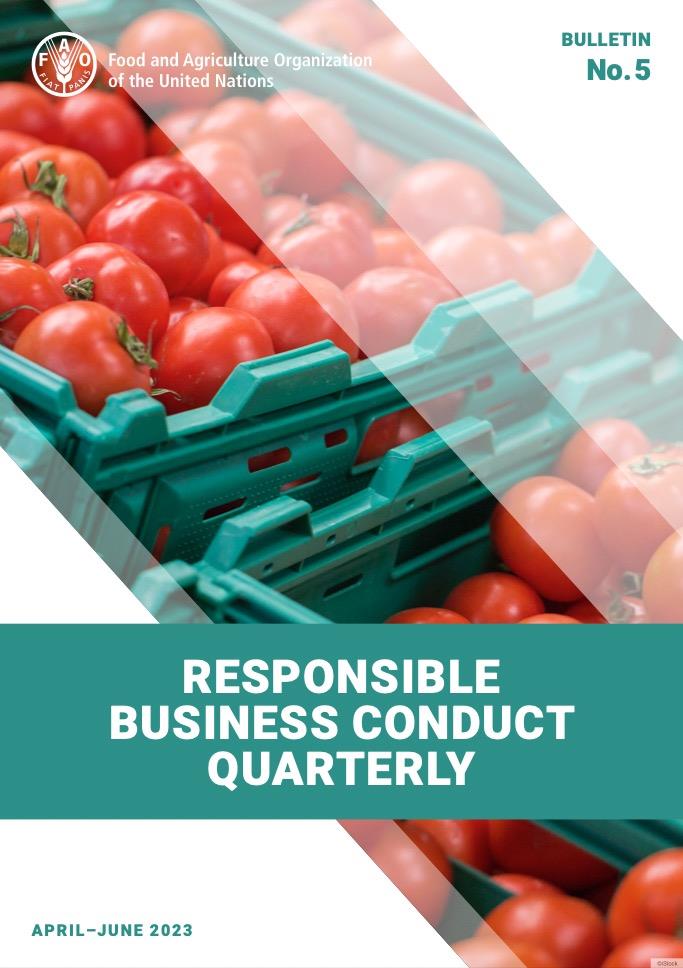
Responsible Business Conduct Quarterly - Bulletin No. 5, April – June 2023
15/06/2023
FAO’s Responsible Business Conduct Quarterly Bulletin (RBC-Q) shares events and resources on FAO’s activities on Responsible Global Value Chains and news from around the world related to business, risk and development in the agricultural sector. It is prepared by FAO’s Markets and Trade Division (EST). This issue of the bulletin covers the period April–June 2023.
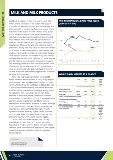
Milk and Milk Products
14/06/2023
World milk production in 2023 is forecast to reach 944 million tonnes, an increase of 0.9 percent from 2022. If confirmed, this would constitute a second consecutive year of slow growth, as foreseen significant year-on-year volume reductions in milk output in South America, Africa, Europe and Oceania are likely to counter the limited expansions expected in Asia, North America and Central America and the Caribbean.
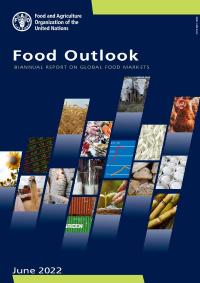
Food Outlook - June 2022
12/06/2023
In view of the soaring input prices,concerns about the weather, and increased market uncertainties stemming from the war in Ukraine, FAO’s latest forecasts point to a likely tightening of food markets in 2022.
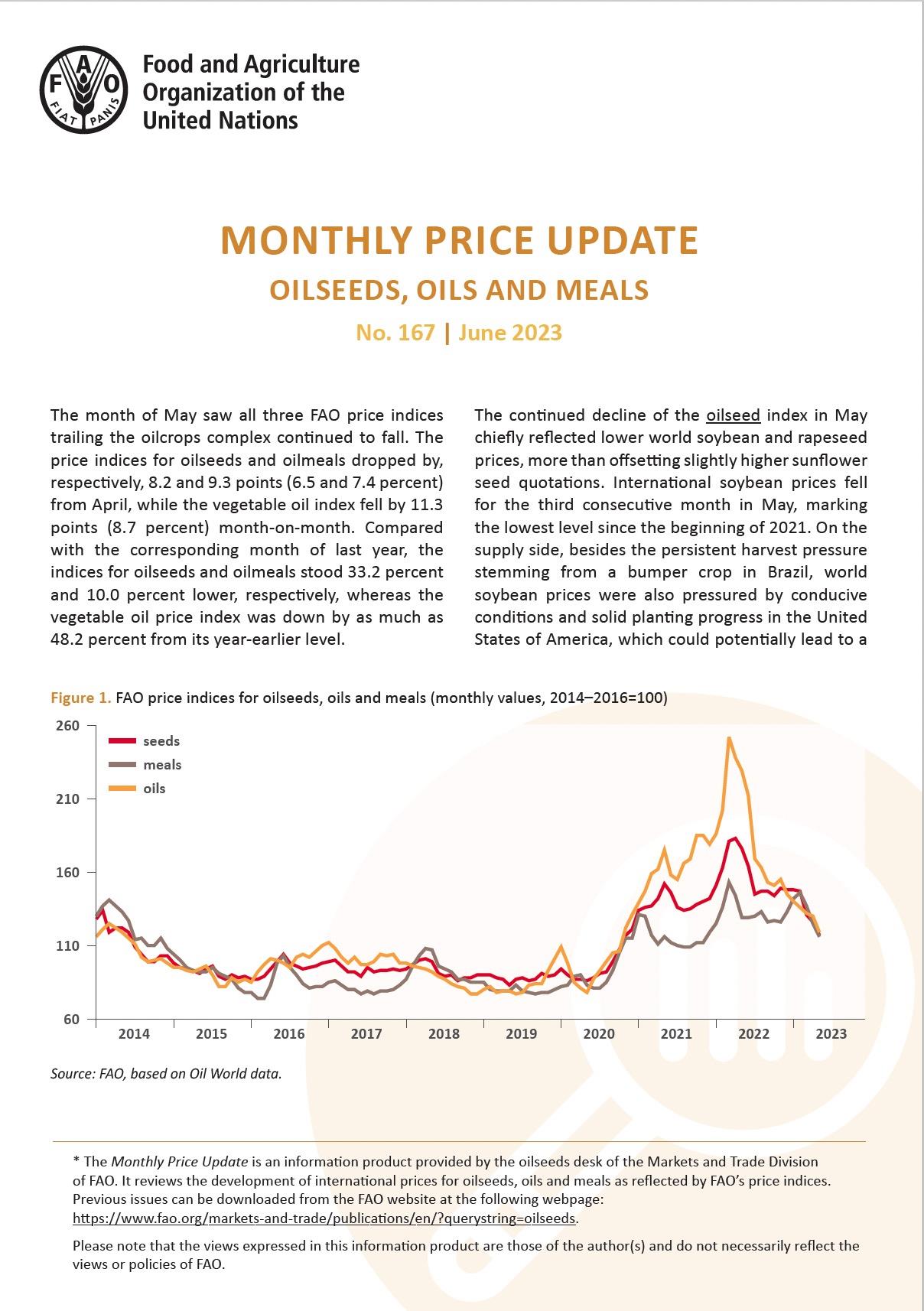
Oilseeds, Oils & Meals. Monthly price update no. 167, June 2023
12/06/2023
The Monthly Price Update is an information product provided by the oilseeds desk of the Markets and Trade Division of FAO. It reviews the development of international prices for oilseeds, oils and meals as reflected by FAO’s price indices.
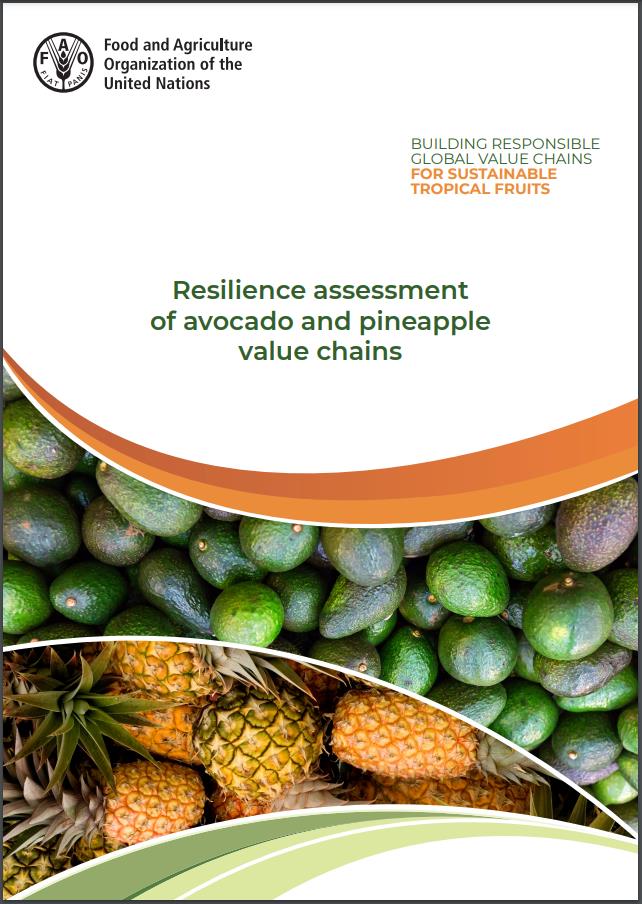
Resilience assessment of avocado and pineapple value chains
09/06/2023
Building resilience is important for agrifood systems – such as tropical fruit value chains – to prepare, withstand and adapt to a wide range of risks, including climate and non-climatic shocks and stresses. Resilience is also important to foster transformation of value chains, to both minimize the negative impacts of external risks on the supply chain and also to prevent new operational problems that could compromise the long-term viability of businesses. The FAO-led Building responsible global value chains for the sustainable production and trade of tropical fruits project conducted a comprehensive study during the last quarter of 2022 to identify the main resilience challenges that participants in the avocado and pineapple sectors are facing. The study also aimed to understand the capacities the actors from both value chains possess to prevent, anticipate, absorb, adapt and transform in view of future climate and socioeconomic risks. The report includes the main results from the study, which were validated by the project participants during a workshop held on 6 December 2022. The findings largely draw on literature review and consultations with some of the main actors from the global avocado and pineapple industries in Africa, Asia and Latin America.
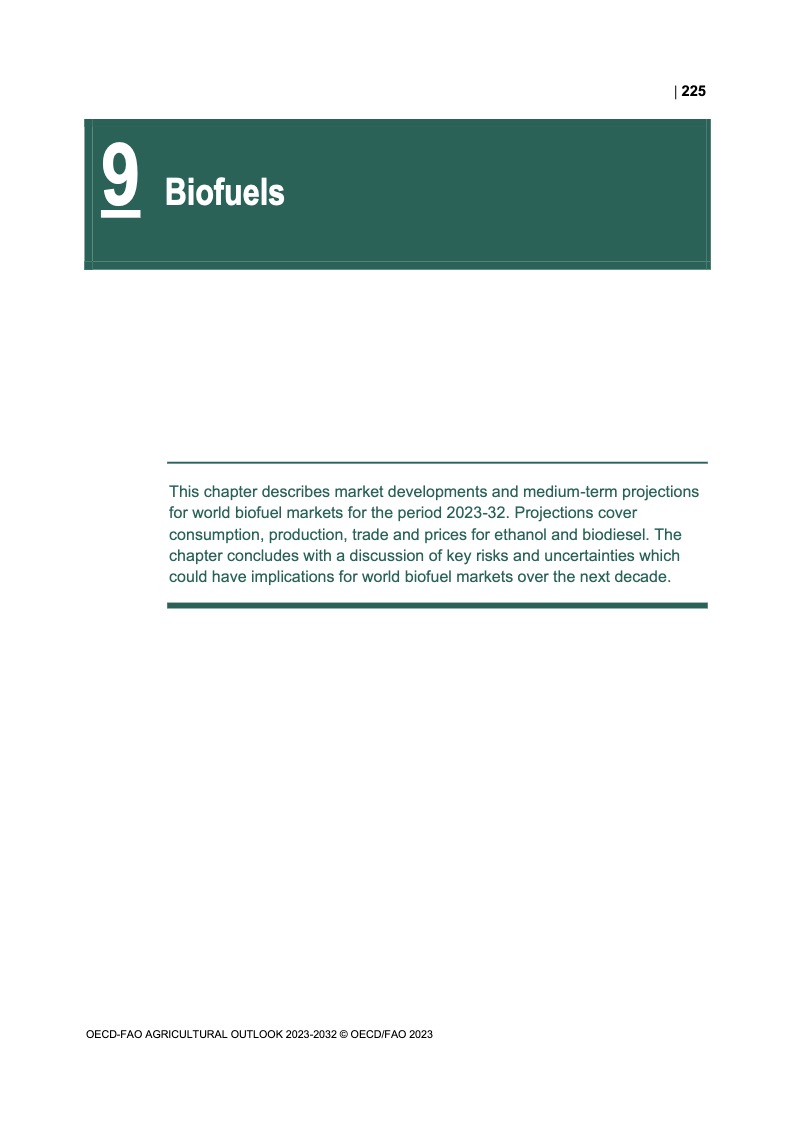
OECD-FAO Agricultural Outlook 2023-2032: Chapter 9 (Biofeuls)
07/06/2023
This chapter describes market developments and medium-term projections for world biofuel markets for the period 2023-32. Projections cover consumption, production, trade and prices for ethanol and biodiesel. The chapter concludes with a discussion of key risks and uncertainties which could have implications for world biofuel markets over the next decade.
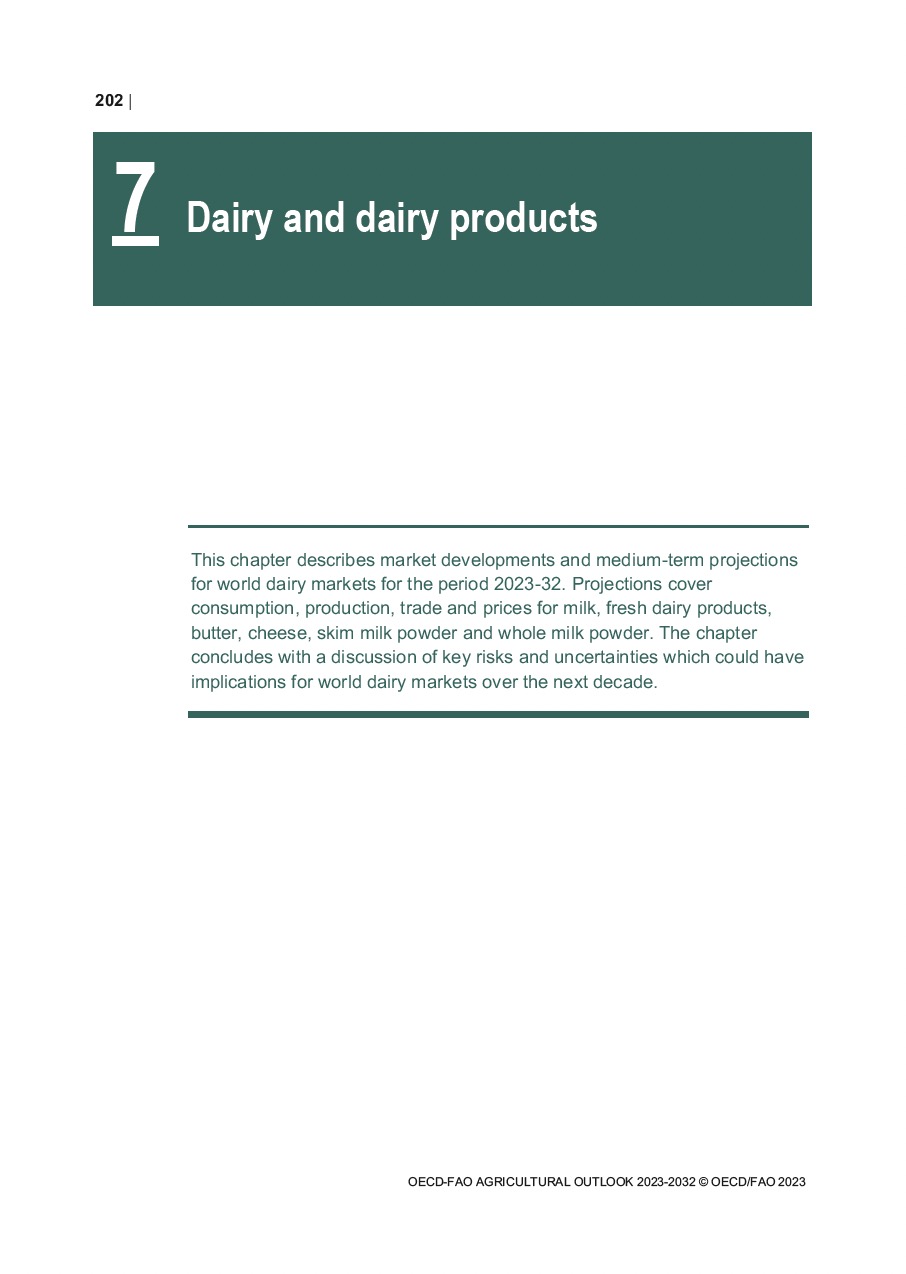
OECD-FAO Agricultural Outlook 2023-2032: Chapter 7 (Dairy and dairy products)
07/06/2023
This chapter describes market developments and medium-term projections for world dairy markets for the period 2023-32. Projections cover consumption, production, trade and prices for milk, fresh dairy products, butter, cheese, skim milk powder and whole milk powder. The chapter concludes with a discussion of key risks and uncertainties which could have implications for world dairy markets over the next decade.

OECD-FAO Agricultural Outlook 2023-2032: Chapter 4 (Oilseeds and oilseed products)
07/06/2023
This chapter describes market developments and medium-term projections for world oilseed markets for the period 2023-32. Projections cover consumption, production, trade and prices for soybean, other oilseeds, protein meal, and vegetable oil. The chapter concludes with a discussion of key risks and uncertainties which could have implications for world oilseed markets over the next decade.

Hunger Hotspots - FAO-WFP early warnings on acute food insecurity, June 2023 to November 2023 outlook
29/05/2023
The Food and Agriculture Organization of the United Nations (FAO) and the United Nations World Food Programme (WFP) warn that acute food insecurity is likely to deteriorate further in 18 hunger hotspots during the outlook period from June to November 2023.
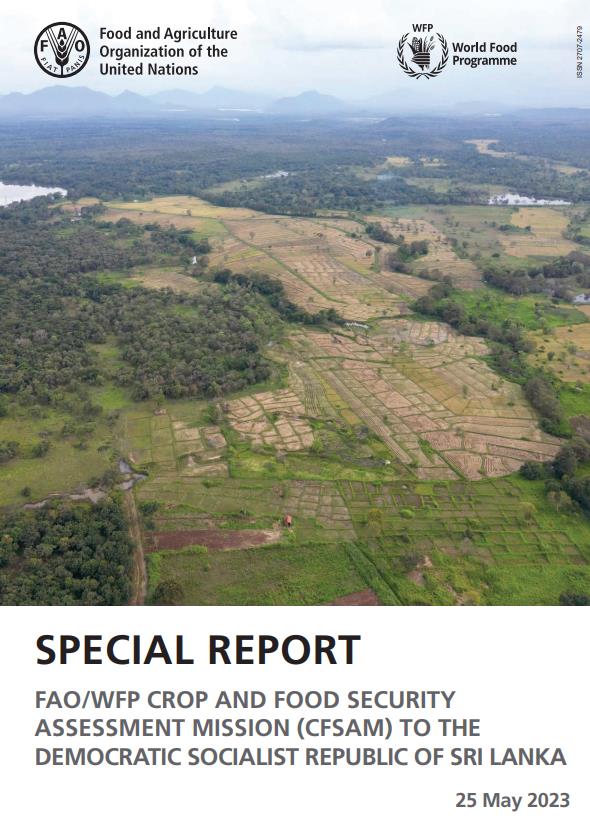
Special Report – FAO/WFP Crop and Food Supply Assessment Mission (CFSAM) to the to Democratic Socialist Republic of Sri Lanka
25/05/2023
At the request of the government, a joint FAO/WFP Crop and Food Security Assessment Mission (CFSAM) visited Sri Lanka from 11 to 31 March 2023 to estimate the 2023 crop production, forecast the country’s cereal import requirements for the 2023 marketing year, and assess household food security conditions. The request was prompted by expectations of a below‑average agricultural output for the second consecutive year in 2023, owing to the effects of the severe macroeconomic crisis that limited imports of most agricultural inputs. To gather information on the conditions of the agriculture sector and household, and nutrition security, the mission held extensive meetings with staff of various government institutions, in particular the Ministry of Agriculture (MoA), the Ministry of Irrigation (MoI) and the “Mahaweli” Authority, the Ministry of Fisheries (MoF) and the National Aquaculture Development Authority (NAQDA), the Ministry of Finance, Economic Stabilization and National Policies (MoFESNP), the Ministry of Trade (MoT), the Department of National Planning (DNP), the Department of Census and Statistics (DCS), the Department of Meteorology, the Paddy Marketing Board (PMB), the National Fertilizer Office, the Agriculture and Agrarian Insurance Board (AAIB), the Central Bank of Sri Lanka (CBS) as well as traders, rice and wheat millers ,and agriculture input importers. In addition, the mission held consultations with staff of the World Bank (WB) and the Asian Development Bank (ADB).

